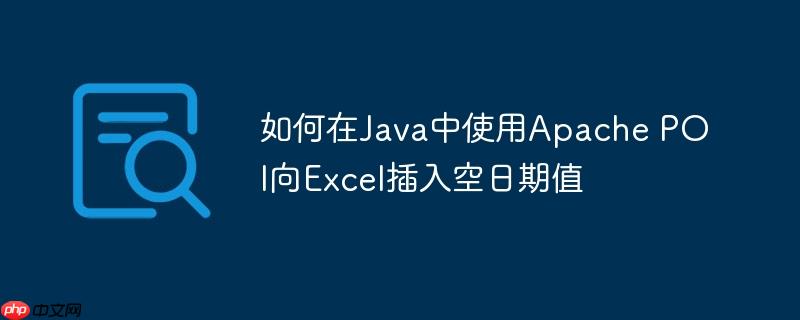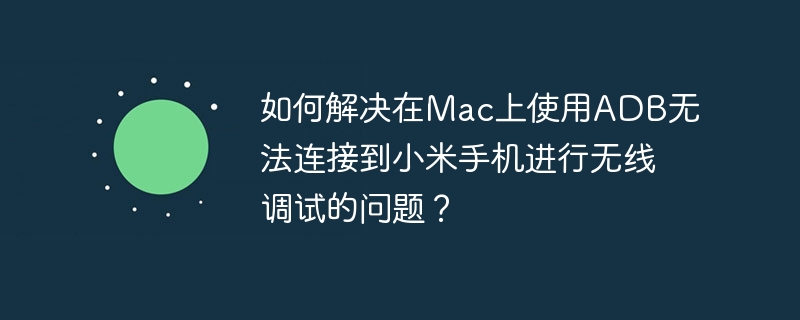
本文将详细讲解在使用apache POI库通过Java代码向excel写入日期数据时,如何避免因日期对象为NULL而导致的NullPointerException。核心解决方案是在尝试设置单元格值之前,对日期对象进行null检查。通过这种方式,可以确保当日期数据缺失时,Excel单元格能够正确地保持为空白状态,从而提高代码的健壮性。
理解问题:日期空值与NullPointerException
在使用apache poi库将java date对象写入excel单元格时,如果尝试将一个null的date对象传递给setcellvalue(date value)方法,程序会抛出java.lang.nullpointerexception。这通常发生在poi内部尝试将java date对象转换为excel日期格式时,例如通过dateutil.getexceldate方法,该方法在处理null输入时会调用Calendar.settime(null),进而引发异常。
考虑以下常见的代码片段,它尝试将学生对象的入学日期写入Excel:
// 假设 studentSheet 和 listOfStudent 已经初始化 // Row studentRow = studentSheet.createRow(0); // 标题行已创建 int studentCount = 1; for(Student student : listOfStudent) { Row studentRow = studentSheet.createRow(studentCount); studentRow.createCell(0).setCellValue(student.getId()); studentRow.createCell(1).setCellValue(student.getName()); // 当 student.getAdmissionDate() 返回 null 时,这里会抛出 NullPointerException studentRow.createCell(2).setCellValue(student.getAdmissionDate()); studentCount++; }
当student.getAdmissionDate()返回null时,XSSFCell.setCellValue(Date)方法内部会触发NullPointerException,导致程序崩溃。
解决方案:在设置值前进行空值检查
解决这个问题的关键在于,在调用setCellValue()方法之前,显式地检查日期对象是否为null。如果日期对象为null,则不调用setCellValue()方法来设置该单元格的日期值。在Excel中,一个未设置任何值的单元格默认为空白(Blank)类型,这正是我们通常期望的“空值”表示。
以下是修正后的代码示例:
立即学习“Java免费学习笔记(深入)”;
import org.apache.poi.ss.usermodel.Row; import org.apache.poi.ss.usermodel.Sheet; import org.apache.poi.ss.usermodel.Workbook; import org.apache.poi.xssf.usermodel.XSSFWorkbook; import java.io.FileOutputStream; import java.io.IOException; import java.util.ArrayList; import java.util.Date; import java.util.List; // 示例 Student 类 class Student { private int id; private String name; private Date admissionDate; public Student(int id, String name, Date admissionDate) { this.id = id; this.name = name; this.admissionDate = admissionDate; } public int getId() { return id; } public String getName() { return name; } public Date getAdmissionDate() { return admissionDate; } } public class ExcelDateNullHandler { public static void generateExcelFile(List<Student> listOfStudent, String filePath) { Workbook workbook = new XSSFWorkbook(); Sheet studentSheet = workbook.createSheet("Students"); // 创建标题行 Row headerRow = studentSheet.createRow(0); headerRow.createCell(0).setCellValue("Id"); headerRow.createCell(1).setCellValue("Name"); headerRow.createCell(2).setCellValue("Admission_Date"); int studentCount = 1; for(Student student : listOfStudent) { Row studentRow = studentSheet.createRow(studentCount); studentRow.createCell(0).setCellValue(student.getId()); studentRow.createCell(1).setCellValue(student.getName()); // 关键:在设置日期值之前进行 null 检查 if (student.getAdmissionDate() != null) { studentRow.createCell(2).setCellValue(student.getAdmissionDate()); } // 如果 student.getAdmissionDate() 为 null,则不对 Cell(2) 调用 setCellValue, // 该单元格将保持为空白状态,这在 Excel 中等同于“空”或“无值” studentCount++; } // 写入文件 try (FileOutputStream fileOut = new FileOutputStream(filePath)) { workbook.write(fileOut); System.out.println("Excel file generated successfully at: " + filePath); } catch (IOException e) { e.printStackTrace(); } finally { try { workbook.close(); } catch (IOException e) { e.printStackTrace(); } } } public static void main(String[] args) { List<Student> students = new ArrayList<>(); students.add(new Student(1, "Alice", new Date())); // 有日期 students.add(new Student(2, "Bob", null)); // 日期为空 students.add(new Student(3, "Charlie", new Date(System.currentTimeMillis() - 86400000L * 30))); // 30天前 generateExcelFile(students, "students_data.xlsx"); } }
注意事项与最佳实践
- 单元格的“空”表示:在Apache POI中,当一个单元格被创建但未调用任何setCellValue方法时,它默认为CellType.BLANK。这在Excel中表现为一个空白单元格,是表示“空值”或“无数据”的常见方式。因此,通过null检查跳过setCellValue调用,正是达到了这一目的。
- 通用性:这种空值检查的原则不仅适用于Date类型,也适用于其他可能为null的对象类型,如String、number等,以避免NullPointerException。虽然setCellValue(String)和setCellValue(double)通常能处理null或默认值(如0.0),但对于对象类型,进行显式检查总是一个好习惯。
- 数据类型匹配:确保你传递给setCellValue方法的数据类型与Excel单元格的预期类型相匹配。例如,日期应使用setCellValue(Date),字符串使用setCellValue(String),数字使用setCellValue(double)。
- 异常处理:在实际应用中,写入Excel文件的操作应该包含适当的try-catch块来处理IOException,确保文件流的正确关闭,如示例所示。
- 防御性编程:在处理来自外部系统或用户输入的数据时,总是假定数据可能不完整或存在null值。在数据处理的早期阶段进行验证和空值检查,可以有效防止运行时错误,提高程序的健壮性。
总结
通过简单的null检查,我们能够优雅地处理Java Date对象为null时向Excel写入数据的问题,避免了NullPointerException。这种方法不仅解决了特定的技术问题,也体现了良好的防御性编程实践,使得生成的Excel文件更加符合预期,且代码更加稳定可靠。在处理任何可能为空的对象数据时,都应考虑采用类似的策略。


















